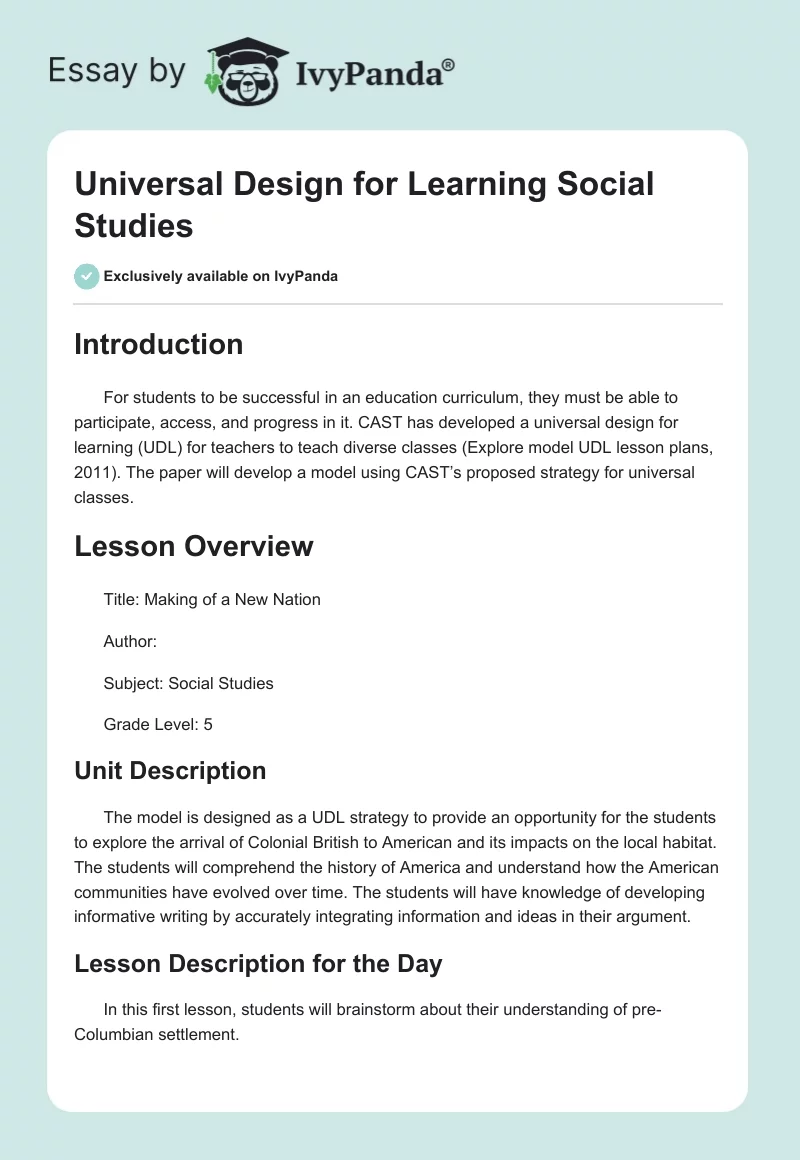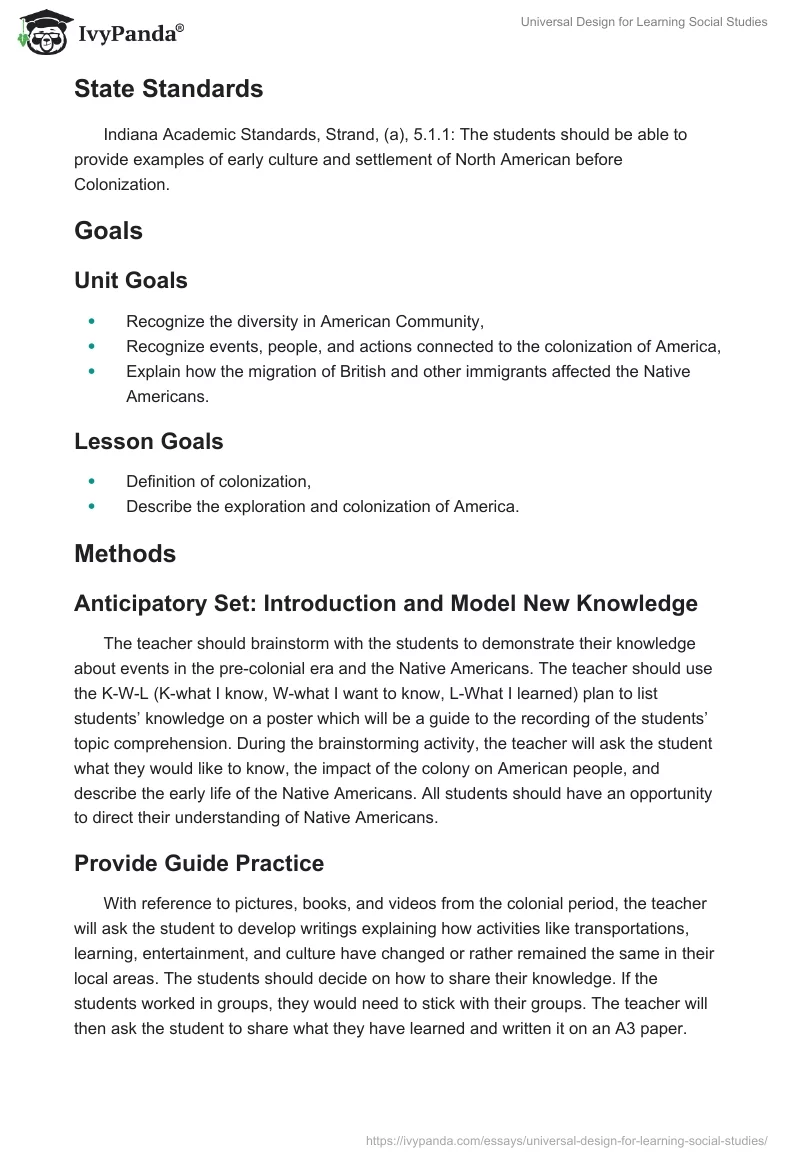Introduction
For students to be successful in an education curriculum, they must be able to participate, access, and progress in it. CAST has developed a universal design for learning (UDL) for teachers to teach diverse classes (Explore model UDL lesson plans, 2011). The paper will develop a model using CAST’s proposed strategy for universal classes.
Lesson Overview
Title: Making of a New Nation
Author:
Subject: Social Studies
Grade Level: 5
Unit Description
The model is designed as a UDL strategy to provide an opportunity for the students to explore the arrival of Colonial British to American and its impacts on the local habitat. The students will comprehend the history of America and understand how the American communities have evolved over time. The students will have knowledge of developing informative writing by accurately integrating information and ideas in their argument.
Lesson Description for the Day
In this first lesson, students will brainstorm about their understanding of pre-Columbian settlement.
State Standards
Indiana Academic Standards, Strand, (a), 5.1.1: The students should be able to provide examples of early culture and settlement of North American before Colonization.
Goals
Unit Goals
- Recognize the diversity in American Community,
- Recognize events, people, and actions connected to the colonization of America,
- Explain how the migration of British and other immigrants affected the Native Americans.
Lesson Goals
- Definition of colonization,
- Describe the exploration and colonization of America.
Methods
Anticipatory Set: Introduction and Model New Knowledge
The teacher should brainstorm with the students to demonstrate their knowledge about events in the pre-colonial era and the Native Americans. The teacher should use the K-W-L (K-what I know, W-what I want to know, L-What I learned) plan to list students’ knowledge on a poster which will be a guide to the recording of the students’ topic comprehension. During the brainstorming activity, the teacher will ask the student what they would like to know, the impact of the colony on American people, and describe the early life of the Native Americans. All students should have an opportunity to direct their understanding of Native Americans.
Provide Guide Practice
With reference to pictures, books, and videos from the colonial period, the teacher will ask the student to develop writings explaining how activities like transportations, learning, entertainment, and culture have changed or rather remained the same in their local areas. The students should decide on how to share their knowledge. If the students worked in groups, they would need to stick with their groups. The teacher will then ask the student to share what they have learned and written it on an A3 paper.
Provide independent Practice
The teacher will divide the students into three groups, with each group having a table. A large chart should be at the center of each table with a question marked at the center. The question will be different from each other as itemized below:
- What is your understanding of the Native Americans?
- Describe the lifestyle of the Native Americans,
- What is your understanding of colonization?
Each group should have less than 6 minutes at each allocated table to answer the provided questions. This should allow the students to work in groups in discussing their comprehension of the topic.
Wrap-Up
The students should develop a brainstorm about the pre-Columbian settlement.
Assessment
Ongoing Assessment
The educator will deliver an ongoing assessment during the lesson by visiting the students in their groups and correcting errors as well as confirming success. The teacher should also encourage the students to participate in the classroom discussion by motivating them to ask questions, and commenting, and suggesting ideas.
Summative/ End of Lesson Assessment
After completion of this activity, the papers will be collected and used as a revision at the beginning of the next session.
Reflection
Before I developed this model, I understood that my priority as a teacher is to decide on how the students should learn and determine their learning activities (CAST, 2010). Therefore, my goals needed to reflect the state’s standard, be clearly stated, have a background, be assessable, and be distinctive from the instruction approach and demonstrate knowledge (Meo, 2008). According to Jackson and Harper (2001), the goals should not have a verb that specifies how the goals should be attained.
For instance, in my model, students were demanded to produce a narrative by writing a text. In case students had disabilities in developing the text, the activity goal could not be achieved. However, my model recommended narrative writing to motivate the student to freely provide the story, thus, achieving the goal of the activity. I also encourage an environment of efficiency and engaged learning by providing room for students to freely speak, read, and listen.
I considered group work as a critical dimension in developing student’s communication skills as well as a way of comprehending the subject matter, motivating engagement, and developing social skills. I also applied the use of books, videos, and pictures so as to stimulate and develop knowledge on the assigned topic. Fisher and Frey (2008) agreed that materials propel new ideas and insights on the selected discussion from different points of view. These strategies will help students avail informative writing by integrating information and ideas so as to present their argument.
During my involvement in this activity, I have learned much about the teaching approach. My interaction with this model has significantly helped me to understand the concepts of goal setting, analysis of the status and application of UDL, as well as how it can be used effectively to accomplish the assigned task and goals. This model has increased my self-awareness and my investment in student learning. I am now able to understand the positive influences that I may be demanded to maintain when pushed to the extreme. I also understood the need to locate, evaluate, and use the information to complete a discussion of the assigned topic.
I think one strategic concept that I will likely apply in the future is the application approach. Since I had identified the student’s diversity using the K-W-L (K-what I know, W-what I want to know, L-What I learned), I believe I can prepare for a universally accessible instructional lesson. Integration of K-W-L into the required learning goal and an inventory of the instructional material will help me identify barriers and challenges that the curriculum presents to the students. Rather than equating information access using my knowledge, using this strategy will help the students to participate in learning and lesson.
The ability of the student to participate in learning will provide me with feedback so that I can easily teach the lesson and reflect on the student’s learning accomplishments. I believe that the main responsibility of a teacher is to engage students emotionally, intellectually, and socially. Therefore, this model has improved my intellectual and social intelligence by providing me with strategies to encourage students to cooperate in learning.
References
CAST (2010). UDL at a glance. Web.
Explore model UDL lesson plans. (2011). Web.
Fisher D. & Frey, N. (2008). Releasing responsibility. Educational Leadership, 66(3), p. 32-37.
Jackson, R., Harper, K., & Jackson, J. (2001). Effective teaching practices and the barriers limiting their use in accessing the curriculum: A review of recent literature. Peabody, MA: Center for Applied Special Technology, Inc.
Meo, G. (2008). Curriculum planning for all learners: Applying universal design for learning (UDL) to a high school reading comprehension program. Preventing School Failure, 52(2), 21-31.


